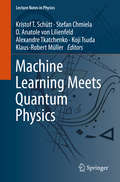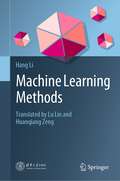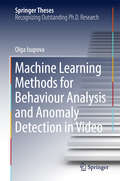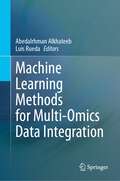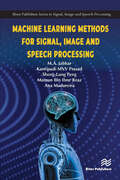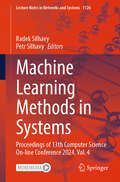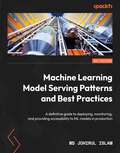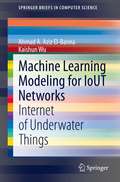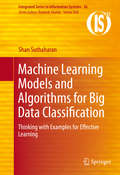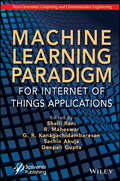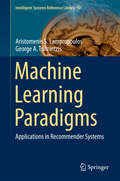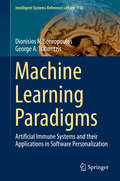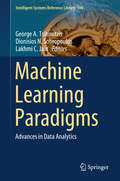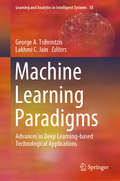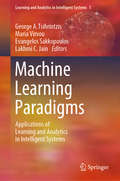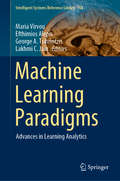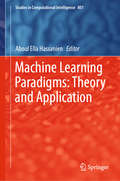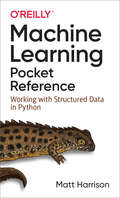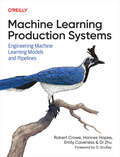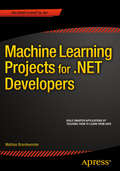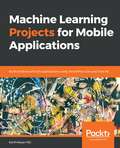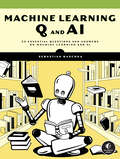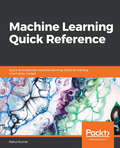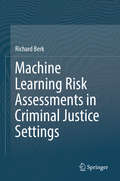- Table View
- List View
Machine Learning Meets Quantum Physics (Lecture Notes in Physics #968)
by Klaus-Robert Müller Kristof T. Schütt Stefan Chmiela O. Anatole von Lilienfeld Alexandre Tkatchenko Koji TsudaDesigning molecules and materials with desired properties is an important prerequisite for advancing technology in our modern societies. This requires both the ability to calculate accurate microscopic properties, such as energies, forces and electrostatic multipoles of specific configurations, as well as efficient sampling of potential energy surfaces to obtain corresponding macroscopic properties. Tools that can provide this are accurate first-principles calculations rooted in quantum mechanics, and statistical mechanics, respectively. Unfortunately, they come at a high computational cost that prohibits calculations for large systems and long time-scales, thus presenting a severe bottleneck both for searching the vast chemical compound space and the stupendously many dynamical configurations that a molecule can assume. To overcome this challenge, recently there have been increased efforts to accelerate quantum simulations with machine learning (ML). This emerging interdisciplinary community encompasses chemists, material scientists, physicists, mathematicians and computer scientists, joining forces to contribute to the exciting hot topic of progressing machine learning and AI for molecules and materials. The book that has emerged from a series of workshops provides a snapshot of this rapidly developing field. It contains tutorial material explaining the relevant foundations needed in chemistry, physics as well as machine learning to give an easy starting point for interested readers. In addition, a number of research papers defining the current state-of-the-art are included. The book has five parts (Fundamentals, Incorporating Prior Knowledge, Deep Learning of Atomistic Representations, Atomistic Simulations and Discovery and Design), each prefaced by editorial commentary that puts the respective parts into a broader scientific context.
Machine Learning Methods
by Hang LiThis book provides a comprehensive and systematic introduction to the principal machine learning methods, covering both supervised and unsupervised learning methods. It discusses essential methods of classification and regression in supervised learning, such as decision trees, perceptrons, support vector machines, maximum entropy models, logistic regression models and multiclass classification, as well as methods applied in supervised learning, like the hidden Markov model and conditional random fields. In the context of unsupervised learning, it examines clustering and other problems as well as methods such as singular value decomposition, principal component analysis and latent semantic analysis. As a fundamental book on machine learning, it addresses the needs of researchers and students who apply machine learning as an important tool in their research, especially those in fields such as information retrieval, natural language processing and text data mining. In order to understand the concepts and methods discussed, readers are expected to have an elementary knowledge of advanced mathematics, linear algebra and probability statistics. The detailed explanations of basic principles, underlying concepts and algorithms enable readers to grasp basic techniques, while the rigorous mathematical derivations and specific examples included offer valuable insights into machine learning.
Machine Learning Methods for Behaviour Analysis and Anomaly Detection in Video (Springer Theses)
by Olga IsupovaThis thesis proposes machine learning methods for understanding scenes via behaviour analysis and online anomaly detection in video. The book introduces novel Bayesian topic models for detection of events that are different from typical activities and a novel framework for change point detection for identifying sudden behavioural changes.Behaviour analysis and anomaly detection are key components of intelligent vision systems. Anomaly detection can be considered from two perspectives: abnormal events can be defined as those that violate typical activities or as a sudden change in behaviour. Topic modelling and change-point detection methodologies, respectively, are employed to achieve these objectives.The thesis starts with the development of learning algorithms for a dynamic topic model, which extract topics that represent typical activities of a scene. These typical activities are used in a normality measure in anomaly detection decision-making. The book also proposes a novel anomaly localisation procedure. In the first topic model presented, a number of topics should be specified in advance. A novel dynamic nonparametric hierarchical Dirichlet process topic model is then developed where the number of topics is determined from data. Batch and online inference algorithms are developed.The latter part of the thesis considers behaviour analysis and anomaly detection within the change-point detection methodology. A novel general framework for change-point detection is introduced. Gaussian process time series data is considered. Statistical hypothesis tests are proposed for both offline and online data processing and multiple change point detection are proposed and theoretical properties of the tests are derived. The thesis is accompanied by open-source toolboxes that can be used by researchers and engineers.
Machine Learning Methods for Multi-Omics Data Integration
by Luis Rueda Abedalrhman AlkhateebThe advancement of biomedical engineering has enabled the generation of multi-omics data by developing high-throughput technologies, such as next-generation sequencing, mass spectrometry, and microarrays. Large-scale data sets for multiple omics platforms, including genomics, transcriptomics, proteomics, and metabolomics, have become more accessible and cost-effective over time. Integrating multi-omics data has become increasingly important in many research fields, such as bioinformatics, genomics, and systems biology. This integration allows researchers to understand complex interactions between biological molecules and pathways. It enables us to comprehensively understand complex biological systems, leading to new insights into disease mechanisms, drug discovery, and personalized medicine. Still, integrating various heterogeneous data types into a single learning model also comes with challenges. In this regard, learning algorithms have been vital in analyzing and integrating these large-scale heterogeneous data sets into one learning model. This book overviews the latest multi-omics technologies, machine learning techniques for data integration, and multi-omics databases for validation. It covers different types of learning for supervised and unsupervised learning techniques, including standard classifiers, deep learning, tensor factorization, ensemble learning, and clustering, among others. The book categorizes different levels of integrations, ranging from early, middle, or late-stage among multi-view models. The underlying models target different objectives, such as knowledge discovery, pattern recognition, disease-related biomarkers, and validation tools for multi-omics data. Finally, the book emphasizes practical applications and case studies, making it an essential resource for researchers and practitioners looking to apply machine learning to their multi-omics data sets. The book covers data preprocessing, feature selection, and model evaluation, providing readers with a practical guide to implementing machine learning techniques on various multi-omics data sets.
Machine Learning Methods for Signal, Image and Speech Processing (River Publishers Series In Signal, Image And Speech Processing Ser.)
by Ana Maria Madureira Sheng-Lung Peng M.A. Jabbar MVV Prasad Kantipudi Mamun Bin ReazThe signal processing (SP) landscape has been enriched by recent advances in artificial intelligence (AI) and machine learning (ML), yielding new tools for signal estimation, classification, prediction, and manipulation. Layered signal representations, nonlinear function approximation and nonlinear signal prediction are now feasible at very large scale in both dimensionality and data size. These are leading to significant performance gains in a variety of long-standing problem domains like speech and Image analysis. As well as providing the ability to construct new classes of nonlinear functions (e.g., fusion, nonlinear filtering).This book will help academics, researchers, developers, graduate and undergraduate students to comprehend complex SP data across a wide range of topical application areas such as social multimedia data collected from social media networks, medical imaging data, data from Covid tests etc. This book focuses on AI utilization in the speech, image, communications and yirtual reality domains.
Machine Learning Methods in Systems: Proceedings of 13th Computer Science On-line Conference 2024, Vol. 4 (Lecture Notes in Networks and Systems #1126)
by Radek Silhavy Petr SilhavyThis book requires an in-depth exploration of machine learning and its integration into system engineering. This book presents contemporary research methodologies, with a strong focus on the innovative application of machine learning techniques in developing and optimizing systems. It includes the meticulously reviewed proceedings from the Machine Learning Methods in Systems session of the 13th Computer Science Online Conference 2024 (CSOC 2024), held virtually in April 2024.
Machine Learning Model Serving Patterns and Best Practices: A definitive guide to deploying, monitoring, and providing accessibility to ML models in production
by Md Johirul IslamBecome a successful machine learning professional by effortlessly deploying machine learning models to production and implementing cloud-based machine learning models for widespread organizational useKey FeaturesLearn best practices about bringing your models to productionExplore the tools available for serving ML models and the differences between themUnderstand state-of-the-art monitoring approaches for model serving implementationsBook DescriptionServing patterns enable data science and ML teams to bring their models to production. Most ML models are not deployed for consumers, so ML engineers need to know the critical steps for how to serve an ML model. This book will cover the whole process, from the basic concepts like stateful and stateless serving to the advantages and challenges of each. Batch, real-time, and continuous model serving techniques will also be covered in detail. Later chapters will give detailed examples of keyed prediction techniques and ensemble patterns. Valuable associated technologies like TensorFlow severing, BentoML, and RayServe will also be discussed, making sure that you have a good understanding of the most important methods and techniques in model serving. Later, you'll cover topics such as monitoring and performance optimization, as well as strategies for managing model drift and handling updates and versioning. The book will provide practical guidance and best practices for ensuring that your model serving pipeline is robust, scalable, and reliable. Additionally, this book will explore the use of cloud-based platforms and services for model serving using AWS SageMaker with the help of detailed examples. By the end of this book, you'll be able to save and serve your model using state-of-the-art techniques.What you will learnExplore specific patterns in model serving that are crucial for every data science professionalUnderstand how to serve machine learning models using different techniquesDiscover the various approaches to stateless servingImplement advanced techniques for batch and streaming model servingGet to grips with the fundamental concepts in continued model evaluationServe machine learning models using a fully managed AWS Sagemaker cloud solutionWho this book is forThis book is for machine learning engineers and data scientists who want to bring their models into production. Those who are familiar with machine learning and have experience of using machine learning techniques but are looking for options and strategies to bring their models to production will find great value in this book. Working knowledge of Python programming is a must to get started.
Machine Learning Modeling for IoUT Networks: Internet of Underwater Things (SpringerBriefs in Computer Science)
by Kaishun Wu Ahmad A. Aziz El-BannaThis book discusses how machine learning and the Internet of Things (IoT) are playing a part in smart control of underwater environments, known as Internet of Underwater Things (IoUT). The authors first present seawater’s key physical variables and go on to discuss opportunistic transmission, localization and positioning, machine learning modeling for underwater communication, and ongoing challenges in the field. In addition, the authors present applications of machine learning techniques for opportunistic communication and underwater localization. They also discuss the current challenges of machine learning modeling of underwater communication from two communication engineering and data science perspectives.
Machine Learning Models and Algorithms for Big Data Classification
by Shan SuthaharanThis book presents machine learning models and algorithms to address big data classification problems. Existing machine learning techniques like the decision tree (a hierarchical approach), random forest (an ensemble hierarchical approach), and deep learning (a layered approach) are highly suitable for the system that can handle such problems. This book helps readers, especially students and newcomers to the field of big data and machine learning, to gain a quick understanding of the techniques and technologies; therefore, the theory, examples, and programs (Matlab and R) presented in this book have been simplified, hardcoded, repeated, or spaced for improvements. They provide vehicles to test and understand the complicated concepts of various topics in the field. It is expected that the readers adopt these programs to experiment with the examples, and then modify or write their own programs toward advancing their knowledge for solving more complex and challenging problems. The presentation format of this book focuses on simplicity, readability, and dependability so that both undergraduate and graduate students as well as new researchers, developers, and practitioners in this field can easily trust and grasp the concepts, and learn them effectively. It has been written to reduce the mathematical complexity and help the vast majority of readers to understand the topics and get interested in the field. This book consists of four parts, with the total of 14 chapters. The first part mainly focuses on the topics that are needed to help analyze and understand data and big data. The second part covers the topics that can explain the systems required for processing big data. The third part presents the topics required to understand and select machine learning techniques to classify big data. Finally, the fourth part concentrates on the topics that explain the scaling-up machine learning, an important solution for modern big data problems.
Machine Learning Paradigm for Internet of Things Applications
by Shalli Rani R. Maheswar G. R. Kanagachidambaresan Deepali Gupta Sachin AhujaMACHINE LEARNING PARADIGM FOR INTERNET OF THINGS APPLICATIONS As companies globally realize the revolutionary potential of the IoT, they have started finding a number of obstacles they need to address to leverage it efficiently. Many businesses and industries use machine learning to exploit the IoT’s potential and this book brings clarity to the issue. Machine learning (ML) is the key tool for fast processing and decision-making applied to smart city applications and next-generation IoT devices, which require ML to satisfy their working objective. Machine learning has become a common subject to all people like engineers, doctors, pharmacy companies, and business people. The book addresses the problem and new algorithms, their accuracy, and their fitness ratio for existing real-time problems. Machine Learning Paradigm for Internet of Thing Applications provides the state-of-the-art applications of machine learning in an IoT environment. The most common use cases for machine learning and IoT data are predictive maintenance, followed by analyzing CCTV surveillance, smart home applications, smart-healthcare, in-store ‘contextualized marketing’, and intelligent transportation systems. Readers will gain an insight into the integration of machine learning with IoT in these various application domains.
Machine Learning Paradigms
by George A. Tsihrintzis Aristomenis S. LampropoulosThis timely book presents Applications in Recommender Systems which are making recommendations using machine learning algorithms trained via examples of content the user likes or dislikes. Recommender systems built on the assumption of availability of both positive and negative examples do not perform well when negative examples are rare. It is exactly this problem that the authors address in the monograph at hand. Specifically, the books approach is based on one-class classification methodologies that have been appearing in recent machine learning research. The blending of recommender systems and one-class classification provides a new very fertile field for research, innovation and development with potential applications in "big data" as well as "sparse data" problems. The book will be useful to researchers, practitioners and graduate students dealing with problems of extensive and complex data. It is intended for both the expert/researcher in the fields of Pattern Recognition, Machine Learning and Recommender Systems, as well as for the general reader in the fields of Applied and Computer Science who wishes to learn more about the emerging discipline of Recommender Systems and their applications. Finally, the book provides an extended list of bibliographic references which covers the relevant literature completely.
Machine Learning Paradigms
by George A. Tsihrintzis Dionisios N. SotiropoulosThis timely book presents Applications in Recommender Systems which are making recommendations using machine learning algorithms trained via examples of content the user likes or dislikes. Recommender systems built on the assumption of availability of both positive and negative examples do not perform well when negative examples are rare. It is exactly this problem that the authors address in the monograph at hand. Specifically, the books approach is based on one-class classification methodologies that have been appearing in recent machine learning research. The blending of recommender systems and one-class classification provides a new very fertile field for research, innovation and development with potential applications in "big data" as well as "sparse data" problems. The book will be useful to researchers, practitioners and graduate students dealing with problems of extensive and complex data. It is intended for both the expert/researcher in the fields of Pattern Recognition, Machine Learning and Recommender Systems, as well as for the general reader in the fields of Applied and Computer Science who wishes to learn more about the emerging discipline of Recommender Systems and their applications. Finally, the book provides an extended list of bibliographic references which covers the relevant literature completely.
Machine Learning Paradigms: Advances in Data Analytics (Intelligent Systems Reference Library #149)
by Lakhmi C. Jain George A. Tsihrintzis Dionisios N. SotiropoulosThis book explores some of the emerging scientific and technological areas in which the need for data analytics arises and is likely to play a significant role in the years to come. At the dawn of the 4th Industrial Revolution, data analytics is emerging as a force that drives towards dramatic changes in our daily lives, the workplace and human relationships. Synergies between physical, digital, biological and energy sciences and technologies, brought together by non-traditional data collection and analysis, drive the digital economy at all levels and offer new, previously-unavailable opportunities. The need for data analytics arises in most modern scientific disciplines, including engineering; natural-, computer- and information sciences; economics; business; commerce; environment; healthcare; and life sciences. Coming as the third volume under the general title MACHINE LEARNING PARADIGMS, the book includes an editorial note (Chapter 1) and an additional 12 chapters, and is divided into five parts: (1) Data Analytics in the Medical, Biological and Signal Sciences, (2) Data Analytics in Social Studies and Social Interactions, (3) Data Analytics in Traffic, Computer and Power Networks, (4) Data Analytics for Digital Forensics, and (5) Theoretical Advances and Tools for Data Analytics. This research book is intended for both experts/researchers in the field of data analytics, and readers working in the fields of artificial and computational intelligence as well as computer science in general who wish to learn more about the field of data analytics and its applications. An extensive list of bibliographic references at the end of each chapter guides readers to probe further into the application areas of interest to them.
Machine Learning Paradigms: Advances in Deep Learning-based Technological Applications (Learning and Analytics in Intelligent Systems #18)
by Lakhmi C. Jain George A. TsihrintzisAt the dawn of the 4th Industrial Revolution, the field of Deep Learning (a sub-field of Artificial Intelligence and Machine Learning) is growing continuously and rapidly, developing both theoretically and towards applications in increasingly many and diverse other disciplines. The book at hand aims at exposing its reader to some of the most significant recent advances in deep learning-based technological applications and consists of an editorial note and an additional fifteen (15) chapters. All chapters in the book were invited from authors who work in the corresponding chapter theme and are recognized for their significant research contributions. In more detail, the chapters in the book are organized into six parts, namely (1) Deep Learning in Sensing, (2) Deep Learning in Social Media and IOT, (3) Deep Learning in the Medical Field, (4) Deep Learning in Systems Control, (5) Deep Learning in Feature Vector Processing, and (6) Evaluation of Algorithm Performance. This research book is directed towards professors, researchers, scientists, engineers and students in computer science-related disciplines. It is also directed towards readers who come from other disciplines and are interested in becoming versed in some of the most recent deep learning-based technological applications. An extensive list of bibliographic references at the end of each chapter guides the readers to probe deeper into their application areas of interest.
Machine Learning Paradigms: Applications of Learning and Analytics in Intelligent Systems (Learning and Analytics in Intelligent Systems #1)
by Lakhmi C. Jain Maria Virvou George A. Tsihrintzis Evangelos SakkopoulosThis book is the inaugural volume in the new Springer series on Learning and Analytics in Intelligent Systems. The series aims at providing, in hard-copy and soft-copy form, books on all aspects of learning, analytics, advanced intelligent systems and related technologies. These disciplines are strongly related and mutually complementary; accordingly, the new series encourages an integrated approach to themes and topics in these disciplines, which will result in significant cross-fertilization, research advances and new knowledge creation. To maximize the dissemination of research findings, the series will publish edited books, monographs, handbooks, textbooks and conference proceedings. This book is intended for professors, researchers, scientists, engineers and students. An extensive list of references at the end of each chapter allows readers to probe further into those application areas that interest them most.
Machine Learning Paradigms: Artificial Immune Systems And Their Applications In Software Personalization (Intelligent Systems Reference Library #118)
by Lakhmi C. Jain Maria Virvou George A. Tsihrintzis Efthimios AlepisThis book presents recent machine learning paradigms and advances in learning analytics, an emerging research discipline concerned with the collection, advanced processing, and extraction of useful information from both educators’ and learners’ data with the goal of improving education and learning systems. In this context, internationally respected researchers present various aspects of learning analytics and selected application areas, including: <P><P> • Using learning analytics to measure student engagement, to quantify the learning experience and to facilitate self-regulation; <P><P> • Using learning analytics to predict student performance; <P><P> • Using learning analytics to create learning materials and educational courses; and <P><P> • Using learning analytics as a tool to support learners and educators in synchronous and asynchronous eLearning. <P><P> The book offers a valuable asset for professors, researchers, scientists, engineers and students of all disciplines. Extensive bibliographies at the end of each chapter guide readers to probe further into their application areas of interest.
Machine Learning Paradigms: Theory and Application (Studies in Computational Intelligence #801)
by Aboul Ella HassanienThe book focuses on machine learning. Divided into three parts, the first part discusses the feature selection problem. The second part then describes the application of machine learning in the classification problem, while the third part presents an overview of real-world applications of swarm-based optimization algorithms. The concept of machine learning (ML) is not new in the field of computing. However, due to the ever-changing nature of requirements in today’s world it has emerged in the form of completely new avatars. Now everyone is talking about ML-based solution strategies for a given problem set. The book includes research articles and expository papers on the theory and algorithms of machine learning and bio-inspiring optimization, as well as papers on numerical experiments and real-world applications.
Machine Learning Pocket Reference: Working with Structured Data in Python
by Matt HarrisonWith detailed notes, tables, and examples, this handy reference will help you navigate the basics of structured machine learning. Author Matt Harrison delivers a valuable guide that you can use for additional support during training and as a convenient resource when you dive into your next machine learning project.Ideal for programmers, data scientists, and AI engineers, this book includes an overview of the machine learning process and walks you through classification with structured data. You’ll also learn methods for clustering, predicting a continuous value (regression), and reducing dimensionality, among other topics.This pocket reference includes sections that cover:Classification, using the Titanic datasetCleaning data and dealing with missing dataExploratory data analysisCommon preprocessing steps using sample dataSelecting features useful to the modelModel selectionMetrics and classification evaluationRegression examples using k-nearest neighbor, decision trees, boosting, and moreMetrics for regression evaluationClusteringDimensionality reductionScikit-learn pipelines
Machine Learning Production Systems: Engineering Machine Learning Models and Pipelines
by Hannes Hapke Robert Crowe Emily Caveness Di ZhuUsing machine learning for products, services, and critical business processes is quite different from using ML in an academic or research setting—especially for recent ML graduates and those moving from research to a commercial environment. Whether you currently work to create products and services that use ML, or would like to in the future, this practical book gives you a broad view of the entire field.Authors Robert Crowe, Hannes Hapke, Emily Caveness, and Di Zhu help you identify topics that you can dive into deeper, along with reference materials and tutorials that teach you the details. You'll learn the state of the art of machine learning engineering, including a wide range of topics such as modeling, deployment, and MLOps. You'll learn the basics and advanced aspects to understand the production ML lifecycle.This book provides four in-depth sections that cover all aspects of machine learning engineering:Data: collecting, labeling, validating, automation, and data preprocessing; data feature engineering and selection; data journey and storageModeling: high performance modeling; model resource management techniques; model analysis and interoperability; neural architecture searchDeployment: model serving patterns and infrastructure for ML models and LLMs; management and delivery; monitoring and loggingProductionalizing: ML pipelines; classifying unstructured texts and images; genAI model pipelines
Machine Learning Projects for .NET Developers
by Mathias BrandewinderMachine Learning Projects for . NET Developers shows you how to build smarter . NET applications that learn from data, using simple algorithms and techniques that can be applied to a wide range of real-world problems. You'll code each project in the familiar setting of Visual Studio, while the machine learning logic uses F#, a language ideally suited to machine learning applications in . NET. If you're new to F#, this book will give you everything you need to get started. If you're already familiar with F#, this is your chance to put the language into action in an exciting new context. In a series of fascinating projects, you'll learn how to: Build an optical character recognition (OCR) system from scratch Code a spam filter that learns by example Use F#'s powerful type providers to interface with external resources (in this case, data analysis tools from the R programming language) Transform your data into informative features, and use them to make accurate predictions Find patterns in data when you don't know what you're looking for Predict numerical values using regression models Implement an intelligent game that learns how to play from experience Along the way, you'll learn fundamental ideas that can be applied in all kinds of real-world contexts and industries, from advertising to finance, medicine, and scientific research. While some machine learning algorithms use fairly advanced mathematics, this book focuses on simple but effective approaches. If you enjoy hacking code and data, this book is for you. What you'll learn Learn vocabulary and landscape of machine learning Recognize patterns in problems and how to solve them Learn simple prediction algorithms and how to apply them Develop, diagnose and tune your models Write elegant, efficient and bug-free functional code with F# Who this book is for Machine Learning Projects for . NET Developers is for intermediate to advanced . NET developers who are comfortable with C#. No prior experience of machine learning techniques is required. If you're new to F#, you'll find everything you need to get started. If you're already familiar with F#, you'll find a wealth of new techniques here to interest and inspire you. While some machine learning algorithms use fairly advanced mathematics, this book focuses on simple but effective approaches and how they can be used in actual code. If you enjoy hacking code and data, this book is for you. Table of Contents Chapter 1: 256 Shades of Gray: Building A Program to Automatically Recognize Images of Numbers Chapter 2: Spam or Ham? Detecting Spam in Text Using Bayes' Theorem Chapter 3: The Joy of Type Providers: Finding and Preparing Data, From Anywhere Chapter 4: Of Bikes and Men: Fitting a Regression Model to Data with Gradient Descent Chapter 5: You Are Not An Unique Snowflake: Detecting Patterns with Clustering and Principle Component Analysis Chapter 6: Trees and Forests: Making Predictions from Incomplete Data Chapter 7: A Strange Game: Learning From Experience with Reinforcement Learning Chapter 8: Digits, Revisited: Optimizing and Scaling Your Algorithm Code Chapter 9: Conclusion
Machine Learning Projects for Mobile Applications: Build Android and iOS applications using TensorFlow Lite and Core ML
by Karthikeyan NgBring magic to your mobile apps using TensorFlow Lite and Core MLKey FeaturesExplore machine learning using classification, analytics, and detection tasks.Work with image, text and video datasets to delve into real-world tasksBuild apps for Android and iOS using Caffe, Core ML and Tensorflow LiteBook DescriptionMachine learning is a technique that focuses on developing computer programs that can be modified when exposed to new data. We can make use of it for our mobile applications and this book will show you how to do so.The book starts with the basics of machine learning concepts for mobile applications and how to get well equipped for further tasks. You will start by developing an app to classify age and gender using Core ML and Tensorflow Lite. You will explore neural style transfer and get familiar with how deep CNNs work. We will also take a closer look at Google’s ML Kit for the Firebase SDK for mobile applications. You will learn how to detect handwritten text on mobile. You will also learn how to create your own Snapchat filter by making use of facial attributes and OpenCV. You will learn how to train your own food classification model on your mobile; all of this will be done with the help of deep learning techniques. Lastly, you will build an image classifier on your mobile, compare its performance, and analyze the results on both mobile and cloud using TensorFlow Lite with an RCNN.By the end of this book, you will not only have mastered the concepts of machine learning but also learned how to resolve problems faced while building powerful apps on mobiles using TensorFlow Lite, Caffe2, and Core ML.What you will learnDemystify the machine learning landscape on mobileAge and gender detection using TensorFlow Lite and Core MLUse ML Kit for Firebase for in-text detection, face detection, and barcode scanningCreate a digit classifier using adversarial learningBuild a cross-platform application with face filters using OpenCVClassify food using deep CNNs and TensorFlow Lite on iOS Who this book is forMachine Learning Projects for Mobile Applications is for you if you are a data scientist, machine learning expert, deep learning, or AI enthusiast who fancies mastering machine learning and deep learning implementation with practical examples using TensorFlow Lite and CoreML. Basic knowledge of Python programming language would be an added advantage.
Machine Learning Q and AI: 30 Essential Questions and Answers on Machine Learning and AI
by Sebastian RaschkaLearn the answers to 30 cutting-edge questions in machine learning and AI and level up your expertise in the field.If you&’re ready to venture beyond introductory concepts and dig deeper into machine learning, deep learning, and AI, the question-and-answer format of Machine Learning Q and AI will make things fast and easy for you, without a lot of mucking about.Born out of questions often fielded by author Sebastian Raschka, the direct, no-nonsense approach of this book makes advanced topics more accessible and genuinely engaging. Each brief, self-contained chapter journeys through a fundamental question in AI, unraveling it with clear explanations, diagrams, and hands-on exercises.WHAT'S INSIDE:FOCUSED CHAPTERS: Key questions in AI are answered concisely, and complex ideas are broken down into easily digestible parts.WIDE RANGE OF TOPICS: Raschka covers topics ranging from neural network architectures and model evaluation to computer vision and natural language processing.PRACTICAL APPLICATIONS: Learn techniques for enhancing model performance, fine-tuning large models, and more.You&’ll also explore how to:• Manage the various sources of randomness in neural network training• Differentiate between encoder and decoder architectures in large language models• Reduce overfitting through data and model modifications• Construct confidence intervals for classifiers and optimize models with limited labeled data• Choose between different multi-GPU training paradigms and different types of generative AI models• Understand performance metrics for natural language processing• Make sense of the inductive biases in vision transformersIf you&’ve been on the hunt for the perfect resource to elevate your understanding of machine learning, Machine Learning Q and AI will make it easy for you to painlessly advance your knowledge beyond the basics.
Machine Learning Quick Reference: Quick and essential machine learning hacks for training smart data models
by Rahul KumarThis book aims at giving machine learning practitioners from different domains - such as data scientists, machine learning developers and engineers – a reference point in building machine learning solutions in practice. Intermediate machine learning developers and data scientists looking for a quick, handy reference to all the concepts of machine learning will find this book to be very useful. Some exposure to machine learning will be required to get the best out of the book.
Machine Learning Refined
by Jeremy Watt Reza Borhani Aggelos K. KatsaggelosProviding a unique approach to machine learning, this text contains fresh and intuitive, yet rigorous, descriptions of all fundamental concepts necessary to conduct research, build products, tinker, and play. By prioritizing geometric intuition, algorithmic thinking, and practical real world applications in disciplines including computer vision, natural language processing, economics, neuroscience, recommender systems, physics, and biology, this text provides readers with both a lucid understanding of foundational material as well as the practical tools needed to solve real-world problems. With in-depth Python and MATLAB/OCTAVE-based computational exercises and a complete treatment of cutting edge numerical optimization techniques, this is an essential resource for students and an ideal reference for researchers and practitioners working in machine learning, computer science, electrical engineering, signal processing, and numerical optimization.
Machine Learning Risk Assessments in Criminal Justice Settings
by Richard BerkThis book puts in one place and in accessible form Richard Berk’s most recent work on forecasts of re-offending by individuals already in criminal justice custody. Using machine learning statistical procedures trained on very large datasets, an explicit introduction of the relative costs of forecasting errors as the forecasts are constructed, and an emphasis on maximizing forecasting accuracy, the author shows how his decades of research on the topic improves forecasts of risk. Criminal justice risk forecasts anticipate the future behavior of specified individuals, rather than “predictive policing” for locations in time and space, which is a very different enterprise that uses different data different data analysis tools. The audience for this book includes graduate students and researchers in the social sciences, and data analysts in criminal justice agencies. Formal mathematics is used only as necessary or in concert with more intuitive explanations.
